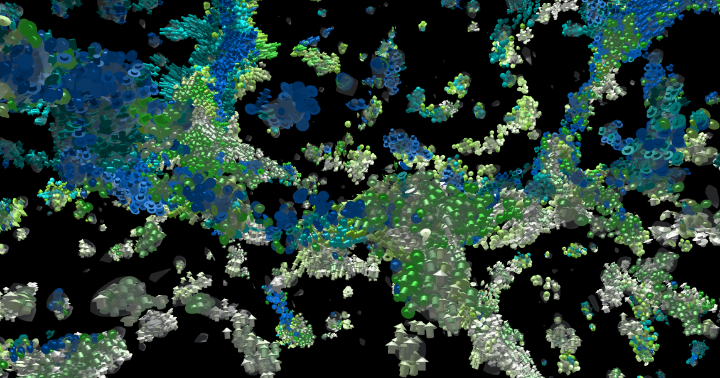Karsten Schatz, Christoph Müller, Patrick Gralka, Moritz Heinemann, Alexander Straub, Christoph Schulz, Matthias Braun, Tobias Rau, Michael Becher, Patrick Diehl, Dominic Marcello, Juhan Frank, Thomas Müller, Steffen Frey, Guido Reina, Daniel Weiskopf and Thomas Ertl of the Visualization Research Center (VISUS) won the SciVis Contest 2019 at IEEE VIS 2019 in Vancouver (Canada). The visualization scientists from Stuttgart presented their work "Visual Analysis of Structure Formation in Cosmic Evolution". VISUS researchers were able to win the IEEE SciVis Contest for the third time with their work on MegaMol (2012, 2016 and 2019).
About the VISUS submission
In their submission, the researchers from VISUS analyze the generation of structure in the cosmic evolution of the universe over the last 5 million years. Starting point is a direct visualization of multivariate data to get an overview and subsequently investigate the impact of Active Galactic Nuclei (AGNs) using various visualization techniques. For instance, an adapted filament detection method was introduced to allow detailed analysis of particle flow near filaments. Based on feedback from astrophysicists on these initial visualizations, they also analyzed X-ray emissions and star formation areas. The periodic conversion of star-forming gas to stars and the resulting increasing molecular weight of the particles could be observed. During the award ceremony the contest judges revealed that this process is part of the actual simulation that produced the data set for the contest.
About MegaMol
MegaMol™ was devised as a visualization platform for point-based data sets, as commonly used in molecular dynamics simulations. Development of this software was started by the Visualization Research Center of the University of Stuttgart (VISUS) in the project D.3 of the SFB 716. The main feature of MegaMol is the interactive visualization of large, time-dependent particle data sets as well as the flexible composition of complex visualization approaches from reusable modules. Using so-called glyph-based representations, data sets with up to 108 particles can be rendered interactively, allowing for explorative analyses.
About IEEE VIS
From October 21 to 25, 2019, around 1000 international researchers from the field of visualization met at this year’s IEEE VIS, which took place in Vancouver (Canada), to exchange views on the latest developments and to discuss current challenges and visions. The conference is considered the largest and most important international platform in this field. Scientists from VIS and VISUS regularly present their research results at this venue.






